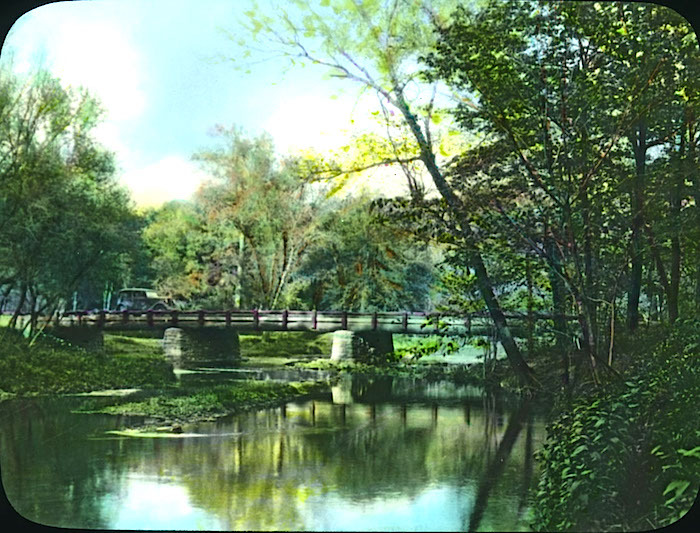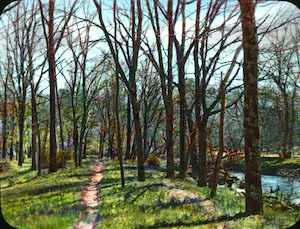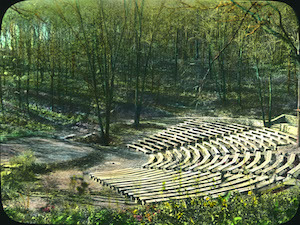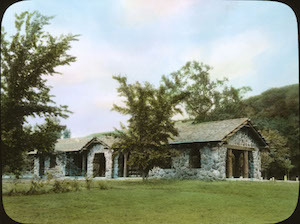
Bridge at Backbone State Park, circa 1930. From the P.H. Elwood Lantern Slide Collection, College of Design Visual Resource Collection.
AMES, Iowa -- With Iowa's state parks experiencing significant cutbacks in staff and services, an Iowa State University landscape architect suggests we look back to 1917 when creating the parks was a priority for Iowa.
This year marks the 100th anniversary of Iowa's state park system, which was in the forefront of state park development nationwide. Remembering the parks' original purpose could help inform how we think about them today, said Heidi Hohmann, associate professor of landscape architecture.
"It's always good to use these anniversaries to see where we were and how far we've come," Hohmann said. "Given that recent news stories report the impact of budget cuts, comparing motivations between then and now may be worth doing. Why were parks a priority in 1917?"
Hohmann said society today likes to think about state parks as "natural, untrammeled" landscapes.
"But the very act of setting these places aside — and designing facilities so that thousands of visitors don't destroy the very thing being protected — also makes them human, or cultural, landscapes," she said. "Between 1910 and 1940, landscape architects defined this new kind of landscape, which still influences the way we think about state and national parks."
Hohmann will discuss the founding of the Iowa state park system and the role Iowa State faculty played in their designs in a talk, "Designing State and National Parks: The Role of ISU Landscape Architects," at 7 p.m. Tuesday, June 6, at the Ames Public Library, 515 Douglas Ave. The free talk is open to the public. It is a complement to the Iowa State University Library Special Collection and University Archives' new exhibition, "The Early Years of Iowa's State Park System," which will run on the fourth floor of Parks Library through the end of 2017.
Both Hohmann's talk and the exhibit describe how Louis Pammel, then-head of the ISU botany department, and Thomas Macbride, the University of Iowa's 10th president and a botany professor, spearheaded the campaign for state parks and for the conservation of significant plants, animals and geology.
Hohmann also will focus on the ISU landscape architects who also participated in the process. She'll talk about how their activities paralleled and sometimes influenced what was happening at the federal level with national parks. And she will touch on the fact that the design of state parks was part of the ISU Extension and Outreach program.
"The ISU landscape architects inventoried the landscapes prior to selection as state parks, and designed the facilities — roads, trails, pavilions, beaches — that allowed people to see and experience these conserved landscapes," she said.
In her talk, Hohmann will introduce people like Arthur Carhart, an ISU alum who became the U.S. Forest Service's first landscape architect; and John R. Fitzsimmons, ISU landscape architecture professor and extension landscape architect. Fitzsimmons did much of the detailed park design of Iowa's state parks, often with the help of ISU landscape architecture students. His students designed everything from lodges and shelter houses to park signs and trail markers.
"In designing facilities whose function and appearance prescribed park experience, Fitzsimmons and his peers also defined the cultural landscape we know today as 'the state park,'" Hohmann said.
Hohmann said more is known about the conservation story in state park history than about the landscape architecture side. That's because most of the park designs created by landscape architects were built by the Civilian Conservation Corps (CCC), so they get "lumped into" CCC design.
"But ISU extension landscape architects and students designed a lot of facilities the CCC built in Iowa's state parks."
Hohmann worked as a preservation landscape architect in the National Park Service and a consultant before pursuing the history of landscape architecture and municipal and national parks as an academic. She became interested in researching the history of the Iowa State landscape architecture department and its relationship to national park design while working on the history of a national park in Oklahoma.
"I discovered that a former ISU faculty member and two ISU-trained landscape architects were the main designers of that park, and another ISU-trained landscape architect was the foreman of one of the CCC crews that built their design."


